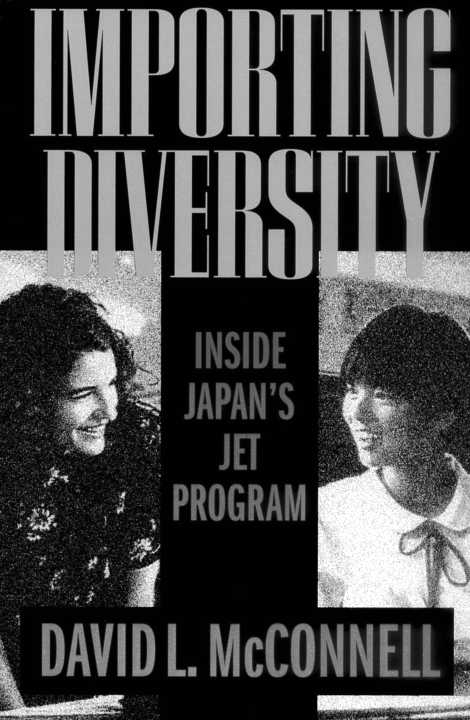Importing Diversity: Inside Japan's JET Program
Read Importing Diversity: Inside Japan's JET Program Online
Authors: David L. McConnell



DAVID L. McCONNELL
Dedicated to the memory of Jackson Bailey, whose
scholarship, values, and commitment to intercultural
exchange served as an inspiration for this study
1. JAPAN'S IMAGE PROBLEM: CULTURE, HISTORY, AND GLOBAL INTEGRATION
2. THE SOLUTION: TOP-DOWN "GRASSROOTS INTERNATIONALIZATION"
3. THE START-UP YEARS: THE "CRASH PROGRAM" NEARLY CRASHES
4. MANAGING DIVERSITY: THE VIEW FROM A PREFECTURAL BOARD OF EDUCATION
5. BEYOND THE STEREOTYPES: THE JET PROGRAM IN LOCAL SCHOOLS
6. THE LEARNING CURVE: JETTING INTO THE NEW MILLENNIUM
EPILOGUE: MIRROR ON MULTICULTURALISM IN THE UNITED STATES
"Show us some leadership, Japan!" This refrain, perhaps more than any
other, sums up Japan's predicament in the waning years of the twentieth
century. Having completed one of the most dramatic economic turnarounds in recorded history, Japan nonetheless continues to suffer from an
acute image problem within much of the international community. The
Gulf War vividly demonstrated the widespread persistence of skeptical attitudes about Japan's motives. After contributing $13 billion to the war effort, Japan was roundly criticized for its "checkbook diplomacy." While the
challenge facing Japan is articulated differently by different observers, all
pose the same underlying question: How has Japan been able to gain so
much economically without experiencing a comparable rise in its international standing?
The usual answer, at least in part, is that for all its overseas connections,
Japan still largely lacks a sense of participation in the larger world. Japan's
intense feelings of isolation and exaggerated sense of uniqueness are increasingly criticized by the rest of the world as barriers to business and by
Japanese themselves as embarrassing social handicaps incommensurate
with Japan's growing status as a world economic leader. Thus, at a time
when pluralist nations around the world are struggling to integrate their
ethnically diverse populations, Japan is under intense international pressure to solve the opposite problem: to "create diversity" and to acquaint its
insulated people with foreigners at the level of face-to-face interaction.
In 1987 the Japanese government decided to address this problem via a
different tack: drop thousands of college graduates primarily from Western
countries into public secondary schools and local government offices in
every corner of the nation. With an annual budget approaching $500 million, the Japan Exchange and Teaching (JET) Program is now the centerpiece of a top-down effort to create "mass internationalization." Eclipsing in
magnitude even such highly regarded exchange programs as the Fulbright
Program and Peace Corps, this effort has been proclaimed by Japanese officials as "the greatest initiative undertaken since World War II related to the
field of human and cultural relations."'
This book examines the struggle for cultural and educational change in
contemporary Japanese society through the lens of the JET Program. It
asks what happens when a country known the world over for its organizational efficiency tackles the thorny issue of coping with diversity. What is
the political symbolism and social reality of "internationalization" in a society structured on modes of social relations very unlike those in most
Western countries? What are the powers and limitations of the Japanese
state in facilitating top-down change? How does the JET Program chart a
course between the sincere desire of the Japanese to raise their status
within the world community and the deep-rooted sense of separateness
still felt by many Japanese today? Relying on two years of fieldwork in
Japan from 1988 to 1990 and four follow-up visits between 1993 and 1999,
I explore these and other questions.
